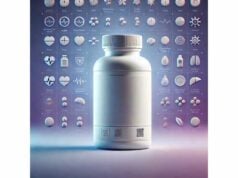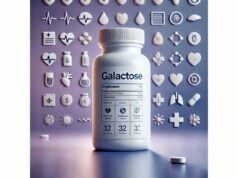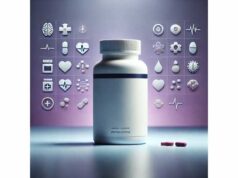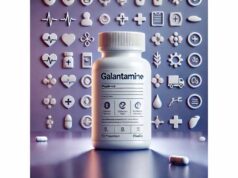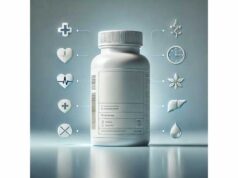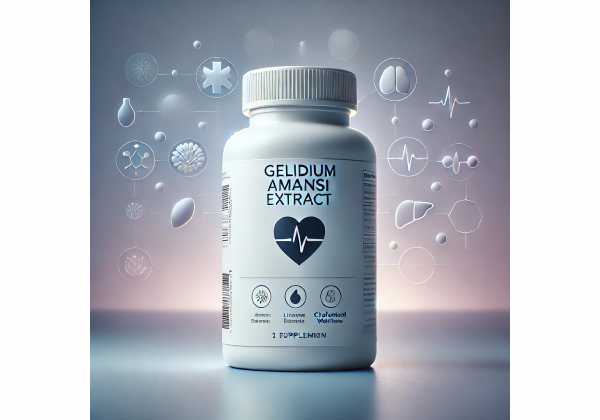
Gelidium amansii is a red seaweed best known as a premium source of agar—the gel-forming fiber used in foods and microbiology. Its concentrated extracts contain soluble polysaccharides (agarose and agaro-oligosaccharides), minor polyphenols, and minerals. Early studies suggest potential support for cholesterol management, metabolic health, gut microbiota balance, and satiety. At the same time, evidence in humans is still limited, and dosing has not been standardized. This guide translates the science into clear, practical steps: what Gelidium amansii extract is, how it may work, how to choose and use products, realistic dosing ranges, safety considerations, and what the evidence actually shows. If you are curious about seaweed-derived fibers beyond kelp and nori, this is a measured, people-first overview to help you decide whether Gelidium amansii extract belongs in your routine.
Quick Overview
- May aid lipid management and metabolic markers via soluble fiber and agaro-oligosaccharides.
- Potential prebiotic effects that support a healthier gut environment.
- Practical daily range: 2–5 g for agar-rich powders or 500–1,000 mg extract 1–2 times daily with water.
- Take with plenty of fluid; can cause gas, bloating, or constipation at high doses.
- Avoid if you have bowel obstruction risk, severe swallowing difficulties, or are pregnant or breastfeeding due to limited data.
Table of Contents
- What is Gelidium amansii extract?
- Proven benefits: what it may help
- How to use it: forms and preparation
- Dosage: how much and when
- Side effects, safety, and who should avoid
- Evidence check: studies and research gaps
What is Gelidium amansii extract?
Gelidium amansii is a red macroalga in the Gelidiaceae family, harvested mainly in East Asia. It is a classic source for high-grade agar—a mix of agarose and agaropectin that forms firm, clear gels at low concentrations. “Gelidium amansii extract” typically refers to a hot-water or ethanol-assisted concentrate of its water-soluble fraction. Depending on processing, this extract can be:
- Agar-rich powder (high in long-chain agarose): functions like a soluble fiber and gelling agent.
- Agaro-oligosaccharides (AOS): shorter chains produced by partial hydrolysis or enzyme treatment, which behave more like prebiotics than gelling fibers.
- Crude extract: contains polysaccharides plus small amounts of polyphenols, pigments, and minerals (potassium, calcium, magnesium, trace iodine depending on harvest and wash steps).
How it may work
- Soluble fiber action. Agar absorbs water, thickens intestinal contents, slows gastric emptying, and can modestly reduce cholesterol absorption and bile acid reabsorption. This is similar to other viscous fibers (e.g., glucomannan, beta-glucan), though agar’s gel strength is distinctive.
- Prebiotic potential. AOS and neo-AOS are fermented by beneficial gut microbes (e.g., bifidobacteria, lactobacilli), producing short-chain fatty acids (SCFAs) like acetate and butyrate that support the gut barrier, immune tone, and lipid metabolism.
- Metabolic signaling. SCFAs and fiber-mediated bile acid changes may influence GLP-1, PYY, and hepatic cholesterol pathways, offering plausible routes to effects on satiety and lipid profiles.
- Antioxidant and anti-inflammatory effects. Minor phenolics and sulfated polysaccharides may modulate inflammatory signaling in preclinical models, though these effects likely play a supporting rather than primary role compared with fiber and prebiotic activity.
What it is not
- It is not iodine-dense like kelp; iodine content is generally lower and depends on cleaning and extraction.
- It is not a stimulant fat burner. Any weight-related effects are most likely fiber-mediated (fullness, reduced energy density, improved lipid handling), which work gradually and depend on diet quality.
Quality markers to look for
- Clear labeling of extract type (agar-rich vs. AOS) and standardization (e.g., % soluble fiber or oligosaccharides).
- Contaminant testing: heavy metals (arsenic, cadmium, lead, mercury) and microbiology.
- Origin and species confirmation: Gelidium amansii, not a different red alga.
- Solubility directions: agar-rich powders should specify hot-or-warm hydration for smooth dispersion.
Proven benefits: what it may help
Cholesterol and lipid management
Agar-rich extracts from Gelidium amansii have repeatedly improved lipid parameters in animal models. Findings commonly include reductions in total cholesterol and triglycerides, along with increased fecal lipid and bile acid excretion. Mechanistically, viscous fiber traps bile acids, promoting their elimination; the liver then draws upon cholesterol to synthesize new bile acids, lowering circulating levels. Fermentation end-products (SCFAs) may further support hepatic lipid regulation. In a diabetic rat model, Gelidium amansii hot-water extract improved hepatic lipid handling even when glucose intolerance persisted—suggesting a primary effect on lipid metabolism rather than on glycemia alone.
Metabolic health and body composition
In diet-induced obese rodents, Gelidium amansii extracts have reduced weight gain and adiposity, with improvements in adipose tissue lipolysis and lipid enzyme activity. These outcomes appear to be driven by a combination of: (1) lower energy density and better satiety from viscous fiber; (2) altered fat absorption; and (3) downstream effects of SCFAs on metabolic signaling. While these results are encouraging, human trials specifically on Gelidium amansii are not yet robust; consider these as hypothesis-generating rather than definitive.
Gut microbiota and digestive comfort
Agaro-oligosaccharides (AOS) derived from Gelidium-type agar show prebiotic activity in vitro and in animal studies. AOS can increase beneficial taxa, improve microbial diversity, and elevate SCFAs. In aging or inflammatory models, AOS has preserved mucosal integrity and reduced inflammatory markers. Practically, people often notice fullness and sometimes more regular bowel movements when introducing agar-type fibers—once the dose is titrated and fluids are adequate. For some, initial gas and bloating settle as the gut adapts.
Glycemic impact
By slowing gastric emptying and modifying the viscosity of intestinal contents, agar may blunt post-meal glucose spikes when taken with carbohydrate-rich meals. However, glucose outcomes are less consistent than lipid outcomes in the preclinical literature, and data in humans with Gelidium amansii are sparse. Think of glycemic effects as possible but not guaranteed, and more modest than dedicated glucose-targeted fibers (e.g., high-molecular-weight barley beta-glucan).
Who may notice benefits
- Individuals focused on cholesterol support alongside diet changes.
- Those seeking gentle appetite control through increased fullness.
- People working on gut health who tolerate marine-fiber prebiotics.
- Cooks and formulators who want a clean-label gel for low-sugar desserts or dairy-free textures with a functional twist.
Who may not
- Anyone with low fluid intake or a history of bowel obstruction should avoid viscous fibers like agar.
- Those with very sensitive GI tracts may not tolerate agar or AOS, especially at higher doses.
Bottom line: the strongest signals are for lipid support and prebiotic effects; weight and glucose effects are plausible but less consistent and need more human research.
How to use it: forms and preparation
1) Agar-rich powders (whole extract or concentrated agar)
These behave like a culinary hydrocolloid and a functional fiber.
- Beverage gel or jelly: Dissolve the measured amount in hot water (near-boiling), whisk thoroughly, sweeten or flavor as desired, pour, and cool to set. Lower concentrations (for soft gels) are more palatable for daily use.
- Smoothies and soups: Hydrate in a small amount of hot water, then blend into warm soups or cool smoothies. Pre-hydration prevents clumps.
- Baking and dairy-free desserts: Replace gelatin 1:1 to 1:1.5 by weight as a vegan gelling agent. Agar gels are firmer and set at room temperature; you may prefer slightly less agar than gelatin to avoid an overly firm texture.
2) Agaro-oligosaccharides (AOS) powders or capsules
AOS is less gelling and more prebiotic.
- Powders: Mix into room-temperature water, yogurt, or smoothies. AOS usually dissolves more easily than agarose-rich powders.
- Capsules: Helpful for people sensitive to texture or taste. Still drink a full glass of water with each serving.
3) Crude Gelidium amansii extract capsules
These often standardize to a percentage of soluble fiber or total polysaccharides. Because products vary, follow label directions and the dosage guidance below.
Stacking with diet and supplements
- With meals that are higher in fat: Agar’s bile-binding effect makes most sense with mixed meals; consider pairing your dose with the day’s richest meal.
- With probiotics: Combining AOS with live cultures (e.g., Lactobacillus, Bifidobacterium) is reasonable; introduce one change at a time so you can tell what is doing what.
- With other fibers: Start low. If you already use viscous fibers (psyllium, glucomannan, inulin), additive effects can cause gas, bloating, or constipation without extra water.
Taste and texture tips
- For agar gels, start at low gel concentrations to avoid a rubbery texture; add citrus or fruit purees for flavor.
- For drink mixes, pre-hydrate agar in hot water and then dilute; or choose AOS for a smoother mouthfeel.
- Always drink extra water—especially with agar-rich powders—to keep stools soft and fiber moving.
Storage and handling
- Keep powders cool, dry, and sealed.
- Use clean, dry scoops to prevent clumping.
- Do not store prepared gels at room temperature for extended periods; refrigerate for food safety.
Dosage: how much and when
There is no officially established human dose for Gelidium amansii extract. Practical ranges depend on the form:
Agar-rich powders (fiber-dominant)
- Typical functional range: 2–5 g per day, taken with at least 250–500 mL of water per gram when used as a drink or gel.
- Timing: With meals, especially those higher in fat or with refined carbs.
- Titration: Begin with 1 g/day for 3–4 days, then increase by 0.5–1 g every few days as tolerated.
Agaro-oligosaccharides (AOS)
- Exploratory prebiotic range: 0.5–2 g per day, often split into two doses.
- Timing: Any time of day with food or water; consistency matters more than timing.
- Titration: Start at 250–500 mg/day and increase gradually. Sensitive individuals may stay at the low end.
Capsule extracts (crude Gelidium amansii)
- Many commercial products provide 500–1,000 mg per capsule. A common pattern is 500–1,000 mg once or twice daily with meals.
- Because extracts vary (some are more fiber-rich, some more oligosaccharide-rich), follow the label and adjust based on GI response and goals.
Special use cases
- Cholesterol support: Favor the upper half of the agar range (3–5 g/day) with the day’s main meal, combined with a heart-healthy pattern (higher in legumes, whole grains, and unsaturated fats).
- Satiety and weight management: Take a smaller dose 15–30 minutes before meals with plenty of water to enhance fullness.
- Gut health focus: Consider AOS 0.5–1.5 g/day, building slowly over two to three weeks.
Hydration rules (important)
- For every 1 g of agar-rich powder, plan on at least 250 mL of water. If stools become hard or you feel abdominal cramping, pause, rehydrate, and reduce the dose.
How long until you notice effects?
- Bowel regularity: often within 3–7 days once you reach a steady dose.
- Satiety and eating patterns: within 1–2 weeks, if you take it consistently around meals.
- Cholesterol: allow 6–8 weeks of daily use alongside diet changes before re-testing.
When to stop or adjust
- Persistent bloating, cramps, or constipation despite hydration.
- Worsening reflux (rare, but gel-forming fibers can affect gastric volume).
- Any symptoms of obstruction (stop and seek medical care).
Side effects, safety, and who should avoid
Common, usually mild effects
- Gas and bloating during the first one to two weeks (microbiota adaptation).
- Fullness or early satiety, which is sometimes the goal but can be uncomfortable if doses are high.
- Changes in stool form (firmer with agar; softer with adequate water and AOS).
Less common risks
- Constipation if taken without adequate fluid or combined with other viscous fibers at high doses.
- Choking or obstruction risk with poorly hydrated gels or in people with swallowing difficulties—this is why hydration is mandatory.
- Medication timing: gels may slow or reduce absorption of some oral medications. Separate fiber-rich doses from medicines by at least 2 hours unless advised otherwise by your clinician.
Allergy and intolerance
- True allergy is rare. Intolerance (bloating, cramps) can occur, particularly at higher doses or with rapid increases. Reduce the dose and build more slowly.
Who should avoid without medical supervision
- History of bowel obstruction, strictures, or motility disorders.
- Significant swallowing difficulties (dysphagia) or esophageal narrowing.
- Post-GI surgery where fiber restrictions are in place.
- Pregnancy and breastfeeding: data on Gelidium amansii-specific extracts are insufficient; avoid unless your clinician recommends and monitors.
- Children: safety data are limited; food-use agar in recipes is generally accepted, but supplement-strength dosing should be supervised by a pediatric clinician.
Conditions requiring extra caution
- Diabetes on medications that lower glucose: small blunting of post-meal spikes is possible; monitor glucose and discuss dose changes with your care team.
- Thyroid disease: while Gelidium amansii is not iodine-rich compared with kelp, total dietary iodine should be considered if multiple seaweed products are used.
- Sensitive IBS or SIBO: introduce AOS or agar slowly; consider starting with AOS micro-doses (250–500 mg/day) to test tolerance.
Quality and purity matter
Marine botanicals can concentrate contaminants. Choose brands that provide third-party testing for heavy metals (arsenic, cadmium, lead, mercury), microbial purity, and residual solvents (if ethanol extractions are used). Prefer lots with transparent species identification and origin.
Drug-nutrient interactions
- Bile acid sequestrants and gel-forming fibers may have additive GI effects; separate dosing.
- Fat-soluble vitamins (A, D, E, K) taken in high single doses could be affected by very high fiber intakes; take at a different time of day.
Evidence check: studies and research gaps
What we have
- Animal models show consistent lipid benefits. In high-fat diet models and diabetic models, Gelidium amansii hot-water extracts improved triglycerides, total cholesterol, and hepatic lipid metabolism. These effects are biologically plausible for a viscous fiber with prebiotic potential.
- Prebiotic rationale is strong. A growing body of work on agaro-oligosaccharides (including those derived from Gelidium-type agar) demonstrates fermentability by beneficial microbes and functional improvements in gut physiology in animals.
- Long history of safe food use for agar. Regulatory reviews have not found a need for a numerical acceptable daily intake for agar used in foods when typical exposures are considered, and short-term human tolerability at several grams per day has been reported in safety assessments.
What we do not have (yet)
- Robust human trials specifically on Gelidium amansii extract. Most controlled human data in the red-algae category involve related species or mixed seaweed interventions. For Gelidium amansii itself, human evidence is limited; dosing guidance therefore borrows from agar food-use data and prebiotic ranges for oligosaccharides.
- Head-to-head comparisons with other fibers. We do not know how Gelidium amansii compares with psyllium, glucomannan, or beta-glucan for lipid or glycemic outcomes in humans.
- Standardized products and biomarkers. Extracts differ widely (agar-dominant vs. AOS-dominant). Future studies should specify molecular weight distribution, degree of polymerization, and sulfate content, and link these to outcomes.
How to read the current evidence
- Strength of evidence is moderate-to-strong in animals, low in humans for Gelidium amansii specifically.
- Effect size expectations (if benefits occur) are in the modest range typical of dietary fibers. Health gains are most likely when Gelidium amansii is used with a diet that emphasizes legumes, whole grains, vegetables, and unsaturated fats.
- Safety looks favorable at food-like doses, provided hydration is adequate. The major real-world risk is GI discomfort from too much, too fast, with too little water.
Research to watch
- Controlled human lipid trials using well-characterized Gelidium amansii extracts at defined fiber equivalents.
- Trials of AOS in humans for metabolic and gut barrier endpoints.
- Work on individual variability, including microbiome predictors of response (who benefits most and who gets gas or bloating).
Take-home
If you want to experiment with a marine-fiber supplement and you tolerate fiber well, Gelidium amansii extract is a reasonable, food-first option to support cholesterol management and gut health. Start low, hydrate well, and pair it with dietary improvements. Expect gradual, not dramatic, changes—and discuss with your clinician if you take medications or have GI conditions.
References
- The Anti-Obesity Effect of Polysaccharide-Rich Red Algae (Gelidium amansii) Hot-Water Extracts in High-Fat Diet-Induced Obese Hamsters 2019
- Polysaccharide-Rich Red Algae (Gelidium amansii) Hot-Water Extracts Alleviate Abnormal Hepatic Lipid Metabolism without Suppression of Glucose Intolerance in a Streptozotocin/Nicotinamide-Induced Diabetic Rat Model 2022
- Agarooligosaccharides as a novel concept in prebiotics 2024
- Re-evaluation of agar (E 406) as a food additive 2016
- Safety and efficacy of a feed additive consisting of agar for pets and non‐food‐producing animals (Hispanagar) 2022
Disclaimer
This information is educational and not a substitute for personalized medical advice, diagnosis, or treatment. Always speak with your healthcare professional before starting, stopping, or changing any supplement, especially if you have medical conditions, are pregnant or breastfeeding, or take prescription medications.
If you found this useful, please consider sharing it on Facebook, X (formerly Twitter), or your favorite platform, and follow us for more evidence-based wellness guides. Your support helps us keep creating high-quality resources.


